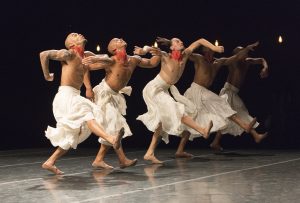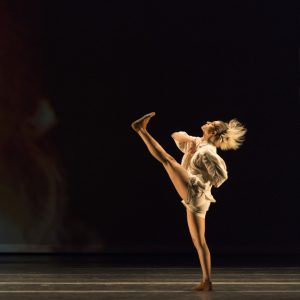
One doesn’t go and see Grupo Corpo — one goes and experiences Grupo Corpo.
The recent performance of this unique contemporary dance company from the interior state of Minas Gerais in Brazil was a total theatrical event that left me feeling enriched and more connected to the vibrant cultural diversity that is Brazil. As the third installment of the popular Modern Dance Series at the Duncan Theatre at Palm Beach Community College in Lake Worth, the show was just as thrilling as Complexions Contemporary Ballet and Bodytraffic, the two previous shows presented so far this season.
Now that I have finally had the opportunity to experience a performance by Grupo Corpo, I understand why their reputation precedes them. How these artists blend their country’s rich cultural tapestry into the art form of dance is something truly worth experiencing.
The program that Grupo Corpo presented on February 23 integrated Brazilian folkloric movement with classical ballet training.All of the group’s performers were outstanding dancers both collectively and individually. They were well-trained, athletic and full of life but there was something extra in how they responded to the music with their movement.
I found it interesting that there were no casting credits or bios for the dancers in the program or online.The program, which was very dense, instead focused on program notes for the choreography and the mission and history of the company, which was founded in 1975. The artistic lineage of Grupo Corpo is with the Pederneiras family.Besides Artistic Director Paulo Pederneiras and company choreographer Rodrigo Pederneiras (who used to also dance with the company), there are at least three other Pederneirases listed in the program in addition to Jose Luiz Pederneiras, who is the company photographer.
There were two substantial works presented on that Friday night.Both were choreographed by Rodrigo Pederneiras, with scenography and lightning by Paulo Pederneiras and danced by the full company of 21 dancers.Each work brimmed with non-stop creative choreography for about 40 minutes but they were like two sides of a coin — each presenting very different elements from Brazil’s varied heritage.
The first work, Gil Refazendo (Gil Remaking), was set to the light-hearted, engaging rhythms of one of Brazil’s most famous musicians, Gilberto Gil, who chose to “reread” his most well-known musical themes and create an original electronic remix that blended the rhythms of samba, bossa nova, and rock.
Choreographer Rodrigo Pederneiras first presented this dance in 2019 but in 2022, after the lengthy interruption of COVID-19, he completely reworked the choreography. Set against projections by Paulo Pederneiras of golden sunflowers that slowly changed from dry and withered to fresh and blooming, the dancers moved languidly across the stage starting with Yasmin Almeida, who made a slow and articulated diagonal of introductory movement.

Dressed in loose white cotton shirts, shorts and pants, the other dancers were introduced as they added more movement phrases helping to develop the choreographic structure. With a laid-back air and genuine expressions of pleasure on their faces, they subtly caught the beat of Gil’s infectious rhythms with their deceptively intricate movements.
Isabella Accorsi and Luan Batista performed a duet filled with wonderful rebound lifts and towards the end, Agatha Faro and Lucas Saraiva (appearing in just nude colored briefs) danced a duet that was more intimate and focused. The whole piece was delightful and upbeat as if Carnival was just around the corner. It looked like so much fun to dance that I wanted to jump up and try to do a little samba myself.
The second work on the program, Gira (2017), was also choreographed by Rodrigo Pederneiras with stage design by Paulo Perderneiras and lighting by Paulo Pederneiras and Gabriel Pederneiras. A gira is a dance to celebrate the orixás (spirits) of Umbanda, which is one of the most practiced religions in Brazil and is a combination of candomblé with Catholicism and Kardec’s Spiritism.
Unique to Umbanda is that the central orixás in many of the rituals are the spirits of African and Indigenous American people and in Gira, the focus was on Exu, the most human of all the African orixás, who has the ability to create either calm or chaos and thus is responsible for the balance of good and bad in human beings.
Right from the onset, this was an arrestingly powerful work. The curtain opened onto a dark stage that was ringed with a string of naked lightbulbs and draped on three sides with black gauze, behind which hidden figures sat silently observing.In different-sized groupings, the figures were drawn into the excitement of the dances by the driving pulse of the soundscape, which was derived from a mix of voices, instruments and electronics by the Sao Paulo music group Metá Metá.

The men and women — all bare-chested with red painted necks — wore full, white linen skirts (designed by Freusa Zechmeistert) that spread out to flare in the stark lighting.It was mesmerizing to watch the performers emerge and disappear from their gauze-covered cocoons to participate in the ritualistic dances.The choreography was layered with distinctive and repeated gestures that Pederneiras had observed from viewing the rites of candomblé and had woven together with clear intention.
Throughout the entire evening, the clarity of the dancers’ unison work was excellent but in Gira — given the idiosyncratic quality of the movement — the ensemble work was particularly impressive and it added to the intensity of the altered conscious quality of the work.
Pederneiras wisely broke up the group sections with well-placed solos and duets.Throughout the evening, the partnering choreography was innovative and effective.In one of the duets in Gira, there was a very arresting start as the couple confronted the audience with direct — yet unseeing — stares. The man (Jonathan de Paula) stood behind the woman (Dayanne Amaral), who was seated on the floor as he repeatedly lifted and dropped her in a dead fall to the floor.Later, in another duet, Karen Rangel jumped up and stood on Rafael Bittar’s thigh before he shook her off and manipulated her in various lifts by completely restraining her by her upper arms. This duet had a controlling and very animalistic, sexual overtone.
Grupo Corpo tours the world performing its unique repertoire that highlights its Brazilian cultural roots and history.They were last seen in this area in 2001.I hope that this extraordinary dance company will return before another 23 years has passed.